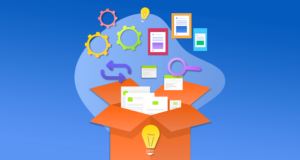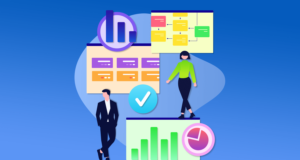Waterfall Management Model: A Complete Guide for PMs
Blog Categories:
Published:
October 29, 2023
Reading Time:
7 minutes

The demand for project managers (PMs) has been steadily increasing and it is estimated that by 2027, approximately 88 million project managers will be needed worldwide, which is equivalent to the population of a whole nation.
These professionals not only launch innovative products but also lead development teams, manage the money, and ensure stakeholder satisfaction.
As their roles encompass various aspects of a business, many consider project management methodologies as crucial tools for high performance and efficiency in their work. According to the State of Project Management report, about 61% of surveyed project managers mostly or always apply a defined project management methodology to their projects.
There are many different project management approaches, each with its own advantages and limitations.
In this blog post, Consultport focuses on the Waterfall management model, one of the most popular methodologies in project management. We’ll guide you through its history, key phases as well as the pros and cons of this method.
These professionals not only launch innovative products but also lead development teams, manage the money, and ensure stakeholder satisfaction.
As their roles encompass various aspects of a business, many consider project management methodologies as crucial tools for high performance and efficiency in their work. According to the State of Project Management report, about 61% of surveyed project managers mostly or always apply a defined project management methodology to their projects.
There are many different project management approaches, each with its own advantages and limitations.
In this blog post, Consultport focuses on the Waterfall management model, one of the most popular methodologies in project management. We’ll guide you through its history, key phases as well as the pros and cons of this method.
Waterfall Management Model’s Definition and History
Waterfall is a popular project management methodology that uses a linear approach. Essentially, this model includes five key phases with each relying on the deliverables of the previous one. Each phase of the workflow in this model must be finished before progressing to the next phase.

It is widely believed that the approach was first introduced in 1970 by Dr Winston W. Royce, an American computer scientist and pioneer in software development. However, Barry W. Boehm wrote that earlier papers had mentioned concepts similar to the waterfall model described by Royce.
Though the exact origins and pioneers of this approach remain uncertain, its values and significance still hold relevance in today’s life.
In the “Real-world Maintainable Software” book, Abraham Marin-Perez wrote that the Waterfall software project management model “took the world by storm”. It was adopted by companies all over the world and included in lecturers by computer science teachers, he said.
Let’s have a look at how this methodology works.

It is widely believed that the approach was first introduced in 1970 by Dr Winston W. Royce, an American computer scientist and pioneer in software development. However, Barry W. Boehm wrote that earlier papers had mentioned concepts similar to the waterfall model described by Royce.
Though the exact origins and pioneers of this approach remain uncertain, its values and significance still hold relevance in today’s life.
In the “Real-world Maintainable Software” book, Abraham Marin-Perez wrote that the Waterfall software project management model “took the world by storm”. It was adopted by companies all over the world and included in lecturers by computer science teachers, he said.
Let’s have a look at how this methodology works.
KEY TAKEAWAYS
- The Waterfall Management Model uses a linear approach. Its five phases progress in a downward flow that resembles a waterfall: Requirements, Design, Implementation, Testing and Verification, and Maintenance.
- Gathering adequate information and data for the planning is key to a successful implementation of the Waterfall method.
- While the linear approach of the Waterfall facilitates clear management and planning, its rigidity might make it difficult for project managers to make changes.
Waterfall Management Model Step by Step
1. Requirements
In the first phase of this model, a product requirement specification document is created. It entails all requirements of the system/product that will be developed.The requirements and documentation needed to obtain in this stage might include:
- A project scope (functional requirements, deliverables, features, deadline, costs, among others)
- Stakeholder expectations (gathered through interviews with stakeholders)
- Research (about the competitors, current market, and customer needs)
- A description of each phase of the project (comprising of information about costs, risks, success metrics, and timeline,…)
2. Design
In this stage, software engineers develop a technical solution to the problems set out in the requirement document. The solution must entail such elements as scenarios, layouts, and data models.Some may break this down into two sub-phases: logical design and physical design. The former includes brainstorming and theorizing potential solutions while the latter involves turning these theoretical ideas into concrete specifications.
As the tasks become available, it is necessary to estimate the time and costs needed for each task and create schedules as well as start building a budget for them
3. Implementation
Once the design is made available, the project should move on to developing the software and system integration according to the requirements and specifications in earlier steps. The system is developed in units which are then integrated and tested for its functionality.In the implementation phase, the team engages in a number of jobs: monitoring and tracking the progress of tasks, managing resources and workload, and reporting to stakeholders.
4. Testing and Verification
In this phase of the Waterfall management model, extensive testing is carried out to ensure the software is free from bugs and defects and that it meets all the requirements. Testing teams will create test cases based on the design documents, personas, and user case scenarios.After the app is delivered, some administrative tasks are needed, including paying contracts to the team and freelance contractors and closing out paperwork.
5. Maintenance
Following the deployment of the software, the maintenance should begin. In case there is a defect or fault as well as a request for change from users, a team will be sent out to handle the updates and release new versions of the software. This phase is ongoing and can extend until the end of the contract.These five phases progress in a cascading way, which makes them look like flowing steadily downwards like a waterfall. Only after the first is completed with goals achieved, the next phase is started.
Who Should Use the Waterfall Methodology?
The Waterfall management model is a perfect method for managers of projects that:

- Have clear requirements
- Possess a clear workflow right from the beginning
- Are unlikely to have their scope change when they are already underway
- Have processes clearly defined with clear requirements of costs, design, and time
- Have end result clearly defined before the launch of the project.

Benefits of the Waterfall Model
With its clear organization, the Waterfall approach offers many benefits:- Project continuity: It ensures the continuity of the project thanks to the emphasis on documentation at all stages.
- Simple and clear planning and scheduling: Each phase in this model is clearly defined and progresses in strict order, enabling clear planning and scheduling. The model is especially beneficial for software projects and complex projects that require the participation of a great amount of staff.
- Easier management: As outputs are clearly identified in each phase, it is easy for managers to manage the project and review the progress.
- Time and budget control: the model helps to prevent a project from exceeding the time and budget limits. With Waterfall mode, project managers can set a schedule with deadlines for each phase. This makes it easy for members to follow the tasks and milestones of the project. It also helps the team save time in the final stages as a clear plan and requirements have been developed earlier.

Limitations of the Waterfall Model
1. Lack of flexibility
One of the key elements that set this model apart is its fixed timeline and budget. Specific goals of the project are set clearly right at the beginning and there is not much feedback expected from the client.This makes the timeline and budget consistent throughout the project. Project managers also find it easier to discuss with stakeholders and business partners.
However, this very feature might become rigid and make the handling of unexpected problems more difficult.
This approach’s heavy emphasis on upfront project planning and high commitment to defined goals reduces its flexibility for adapting to unpredictable events.
With this model, there is no room for factors that are unknown in the initial stages but become known as the project progresses. These factors can range from additional requirements, and technical complexities, to risks, and potential constraints.
Sometimes a problem is identified only when proceeding to a certain phase. For example, difficulties in the implementation phase might signal some flaws in the design. The problem is that the issue might become only apparent at the implementation or verification stage.
2. Lack of understanding of clients’ needs
Another limitation of the Waterfall management model is that sometimes it is difficult for clients to articulate their exact needs at the beginning of the project. They do not have a full understanding of what they want and are open to requests for changes and new features that may come in later stages.3. Linear approach
In addition, Waterfall’s linear approach means that each stage of the project needs to be completed before proceeding to the next step. In other words, one stage doesn’t start until the previous one is completed.When there is a delay in a phase, all others will be affected. For example, a project might get stuck in the verification stage and can’t move forward when it is too difficult to get verification for a design. In case the clients are not satisfied with the product in a certain phase, it can be very costly to go back and make changes.
There’s no better way to prevent this from happening than obtaining sufficient information and data for the planning in the early stages. This will help to avoid going back to a phase, which can be time-consuming and expensive.
Or, at the very least, it is advisable to make alterations during the initial stages when project managers are still working with their teams and clients on the specification documents. Otherwise, making changes later in the project can become challenging and costly.
Conclusion
Like many other approaches like Agile, Scrum, and Kanban, the Waterfall management model has its own pros and cons that project managers have to keep in mind to make the best use of it.
Some might work better in particular fields, projects, or clients, therefore it is important for managers to decide which one works best for them.
Here at Consultport, with a detailed, in-depth understanding of various methodologies, our project management consultants have successfully helped firms better manage their teams and achieve goals with these methods.
Some might work better in particular fields, projects, or clients, therefore it is important for managers to decide which one works best for them.
Here at Consultport, with a detailed, in-depth understanding of various methodologies, our project management consultants have successfully helped firms better manage their teams and achieve goals with these methods.
Share This Story, Choose Your Platform!



